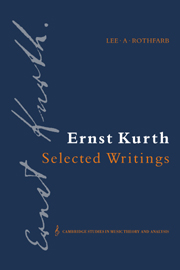Book contents
- Frontmatter
- Contents
- Foreword by Ian Bent
- Preface
- Notes on the translation
- Introduction
- Part I Grundlagen des linearen Kontrapunkts (Foundations of linear counterpoint)
- 1 Polyphonic structure
- 2 Thematic and motivic processes
- 3 Polyphonic melody
- Part II Romantische Harmonik und ihre Krise in Wagners “Tristan” (Romantic harmony and its crisis in Wagner's “Tristan”)
- Part III Bruckner
- Appendix: Complete tables of contents for Kurth's Grundlagen des linearen Kontrapunkts, Romantische Harmonik und ihre Krise in Wagners “Tristan” and Bruckner
- Select bibliography
- Index of musical examples
- General index
1 - Polyphonic structure
Published online by Cambridge University Press: 10 December 2009
- Frontmatter
- Contents
- Foreword by Ian Bent
- Preface
- Notes on the translation
- Introduction
- Part I Grundlagen des linearen Kontrapunkts (Foundations of linear counterpoint)
- 1 Polyphonic structure
- 2 Thematic and motivic processes
- 3 Polyphonic melody
- Part II Romantische Harmonik und ihre Krise in Wagners “Tristan” (Romantic harmony and its crisis in Wagner's “Tristan”)
- Part III Bruckner
- Appendix: Complete tables of contents for Kurth's Grundlagen des linearen Kontrapunkts, Romantische Harmonik und ihre Krise in Wagners “Tristan” and Bruckner
- Select bibliography
- Index of musical examples
- General index
Summary
The passages translated in our chapter 1 are from Grundlagen des linearen Kontrapunkts, 3rd ed., part 1, chapter 5 (pp. 58–63, 66–67); part 2, chapter 4 (pp. 142–45); and part 4, chapters 1 (pp. 361–69, 372–73) and 2 (pp. 374–82). In part 1 of Grundlagen, “Foundations of melody,” Kurth proposes the idea that melody – and music generally – is sonically manifest psychic motion (pp. 4, 8). Based on that premise he distinguishes between interior and exterior music, similar to Arthur Schopenhauer's distinction between the noumenal and phenomenal worlds (p. 6), and interprets this inner/outer modality psychologically (pp. 4, 7, 8, 14). He goes on to theorize broadly about melody, about its genesis, understood holistically (pp. 14–16, 21–24); its essence, identified metaphorically as “kinetic” energy (pp. 9–12); about the relationship of such energy to rhythm (pp. 51–54); about various fundamental melodic phenomena (scale, leading tone, dissonance, chromaticism, pp. 39–51); and about the effect of melody on harmony, which leads to the notion of “potential” energy (pp. 68–96).
The first section translated below, “Approach to compositional technique,” deals with melodic versus harmonic approaches to Bach's music. Kurth challenges contemporary, primarily harmonic interpretations of the music, and presents historical and psychological evidence to support his melodic-genetic view. He argues that harmony in Bach's polyphony is an equilibrium of horizontal and vertical forces. Melodic strands “get caught” in chords, which are thus imbued with potential energy (pp. 61–62).
- Type
- Chapter
- Information
- Ernst Kurth: Selected Writings , pp. 37 - 57Publisher: Cambridge University PressPrint publication year: 1991



